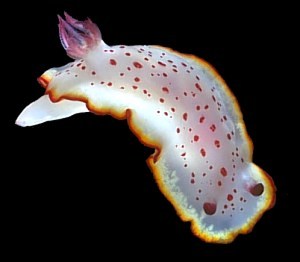
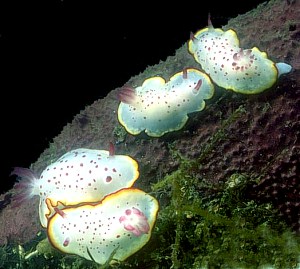
Chromodoris daphne
(Angas, 1864)
Order: NUDIBRANCHIA
Suborder: DORIDINA
Family: Chromodorididae
PHOTO
UPPER: Shiprock, Port Hacking, Sydney, New South Wales, 3m, March 1982.
LOWER: Shiprock, Port Hacking, Sydney, New South Wales, December 1982, on food sponge.
PHOTOS: Bill Rudman.
There are many red and orange-spotted species of chromodorid in New South Wales and southeastern Australia. I have discussed this example of mimicry on a separate page.
References:
• Rudman, W.B. (1983a) The Chromodorididae (Opisthobranchia: Mollusca) of the Indo-West Pacific: Chromodoris splendida, C. aspersa and Hypselodoris placida colour groups. Zoological Journal of the Linnean Society 78: 105-173.
• Rudman, W.B. (1991) Purpose in Pattern: the evolution of colour in chromodorid nudibranchs. Journal of Molluscan Studies, 57, (T.E. Thompson Memorial Issue): 5-21.
Rudman, W.B., 1999 (June 1) Chromodoris daphne (Angas, 1864). [In] Sea Slug Forum. Australian Museum, Sydney. Available from http://www.seaslugforum.net/find/chrodaph
Related messages
Re: Chromodoris daphne from sthn Queensland
January 23, 2009
From: Denis Riek
Concerning message #22165:
Dear Bill,
Chromodoris daphne is also a frequent visitor to the Brunswick River northern New South Wales, Australia and the timing of its (and other opisthobranchs) appearances may indicate if it is a direct developer or, as you believe, lecithotrophic. I have seen at least half a dozen flood episodes in this small river since I have been recording the marine life in it and have observed that the repopulation always follows a constant pattern. Firstly I must say that nearly everything is wiped out in a flood with only the hardiest estuary species surviving and I dont believe that any slugs survive the fresh water and topsoil that pours out.
It usually takes about 3 months before the first slugs show up and they are always Austraeolis ornata and Jorunna sp 1. Plocamopherus imperialis then arrives on the main sea wall and Dendrodoris denisoni and Dendrodoris fumata show up further upstream. Sometimes Aplysia spp also arrive. It is always after these species establish that chromodorids appear about half a kilometre up river and always on the same rock wall. Chromodoris geometrica, Chromodoris daphne, Chromodoris cf reticulata and Hypselodoris obscura all appear about the same time and what is curious is that they are often large animals with almost no juveniles seen, and I have always had a thorough search before hand.
After this amount of time (about 4-6 months) all manner of species begin to show and it becomes difficult to establish a pattern but the diving rapidly improves!
If no slugs survive after a flood (chromodorids definitely dont) how do these species re-establish. The odd animal may come in on weed but the regularity of their arrival seems to indicate that they must have at least a short planktonic stage and can only establish once their food source is present. I have no qualification to make any assumption but I believe that my observation is correct so I would appreciate your opinion
Regards
Denis
dwriek@optusnet.com.au
Riek, D.W., 2009 (Jan 23) Re: Chromodoris daphne from sthn Queensland. [Message in] Sea Slug Forum. Australian Museum, Sydney. Available from http://www.seaslugforum.net/find/22175Dear Denis,
Thanks for this interesting account. We have similar catastrophic events in Sydney Harbour after extended periods of drought. Because of the nature of the harbour the sea water is not totally replaced by fresh floodwater but a layer of freshwater - perhaps a metre deep - overlies the seawater in the harbour and kills off all organisms attached down at least 1.5 metres. This destroyed a research project one time on different colour forms of the little direct developing chromodoridNoumea haliclona killing both the slugs and their food sponges. It was some months before they returned intertidally and we assumed that as the slug was a direct developer, repopulation occurred from animals living deeper in the harbour. River mouths such as the Brunswick River probably represent a different situation because the flood water I would assume, would replace all the seawater and kill all the organisms apart from the few hardy species you refer to.
In cases like this species with free-swimming larvae are probably the most likely to return quickly because their larvae are more capable of quich dispersal. The other thing to take into account is when the catastrophe occurs. Some species only reproduce once a year or for a short period duting the year. And some larvae are short-lived and some need months in the plankton to mature. So if the catastrophe occurs at the 'wrong' time it could be months before some species have larvae available to recolonise an available space. Some species, which are commonly called 'tramp species' seem to appear quickly whenever a space becomes available. There are a number of bryozoans which are good at that, and they often occur with attendant bryozoan feeding nudibranchs.
We basically need to know a lot more about the lifecycles of the nudibranchs and of the food organisms - algae, sponges, hydroids, bryozoans etc - before we can say much more about how nudibranchs re-establish themselves at certain places after catastrophes. It is a very interesting - if very complicated topic.
Best wishes,
Bill Rudman
Re: Chromodoris daphne feeding observation [2]
January 22, 2009
From: Leanne and David Atkinson
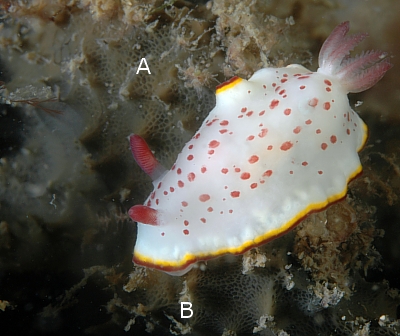
Concerning message #22154:
Dear Bill,
In answer to your question:
"I wondered if two sponge species were interwoven, but I suspect the bluish regions are paler parts of the Chelonaplysilla - perhaps where the slug has been feeding. I would be interested in your comments. Do you perhaps have a photo showing the join between blue and darker regions more clearly?"
We have another photo of each nudibranch and sponge in the previous message. The two we sent in showed the mouth everted and indicated feeding better than the ones we didn't send. Here are the two other photos. We think what you are seeing is not two sponges but the hills and hollows of the sponge making shadows and light. We will keep looking for Chromodoris daphne feeding and see if we can come up with some photos that clear up the puzzle.
Locality: The Pipeline, Nelson Bay, Port Stephens and Fly Point, Port Stephens-Great Lakes Marine Park, Port Stephens , 5metres, New South Wales, Australia, Pacific Ocean, 09 January 2009 & 10 January 2009, Sandy silty bottom with sponges, ascidians, gorgonias, soft corals, hydroids and seaweed. Length: 30 mm. Photographer: Leanne and David Atkinson.
Regards,
Leanne and David Atkinson
atk@hunterlink.net.au
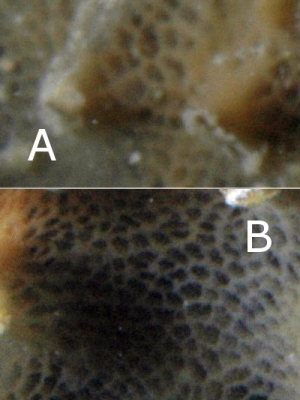
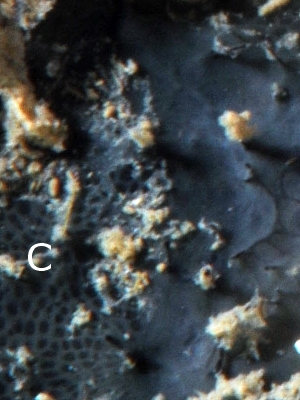
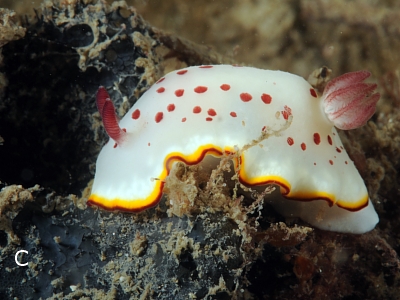
Thanks Leanne and David,
I think these extra photos have cleared up the puzzle quite well. Some sponges change colour in different parts of the same colony - certainly parts that are shaded are often much paler or almost colourlesss. It seems as though Chelonaplysilla violacea can range in colour from deep violet to dull blue to a reddish colour and also to a pale straw colour. One of the distinguishing features of Chelonaplysilla is its incorporation of small sand grains into its tissue which can usually be seen in C. violacea, in the granular appearance of the honeycomb-like surface of the colony. Interestingly your lower photo shows part of the honeycomb layer [C] being hidden by a smooth layer with raised conical papillae more typical of the related genera Darwinella. If I had seen the smooth section only I wouldn't have thought of it as Chelonaplysilla.
As I have often said, sponges are notoriously difficult to identify externally, and one of the reasons for this is that we don't have a good idea of the variability of living colonies. Although this is not a 'sponge forum' our growing collection of 'nudibranch food' photos is increasing our knowledge in both fields of biology.
Best wishes,
Bill Rudman
Chromodoris daphne from sthn Queensland
January 20, 2009
From: Gary Cobb
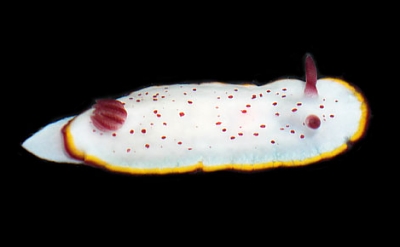
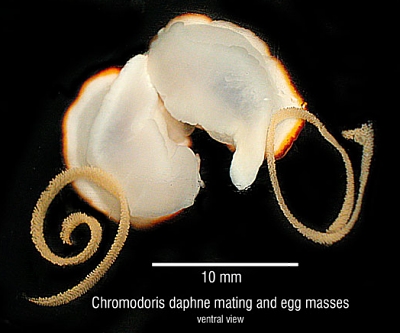
Concerning message #22154:
Hi Bill and everyone!
So Chromodoris daphne is the hot topic ... I won't go into feeding but will go into egg masses and mating.
This species is fairly common here and is typically a botton dweller. In all the dive we have seen it, it has been crawling along the silty sandy bottom. It has been found intertidally and at the Mooloolaba rock wall/ledges, which is a shore dive and Old Woman Island and the local reefs.
I collected a couple to see if they would lay eggs and walla ... two animals laid egg masses together at the same time and then went right back to mating! I could not believe my eyes.
Locality: Mooloolaba, Sunshine Coast, intertidal down to 20 m, sthn Queensland, Australia, Pacific Ocean, 20 January 2009. Length: 15-25 mm. Photographer: Gary Cobb.
Cheers
Gary
gary@nudibranch.com.au
Cobb, G.C., 2009 (Jan 20) Chromodoris daphne from sthn Queensland. [Message in] Sea Slug Forum. Australian Museum, Sydney. Available from http://www.seaslugforum.net/find/22165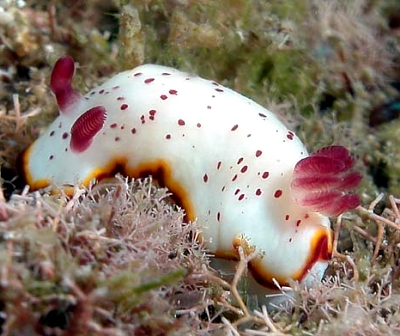
Thanks Gary,
It's nice to get more information about your southern Queensland fauna, which is a mixture of typical tropical Pacific and the endemic fauna restricted to sthn Queensland and New South Wales. Chromodoris daphne is a good example of this endemic fauna. As we can see in the Atkinson's message [#16171] and yours, the eggs in this species are large enough to suggest the larvae are probably not free-swimming, plankton-feeding veliger larvae. They possibly have direct development hatching directly as small crawling slugs, or more likely they have lecithotrophic larvae, which are non-feeding veliger larvae which spend only a small time in the plankton bwfore settling down as crawling slugs. Hopefully your egg coils will survive and give us a few clues on their development type.
Best wishes,
Bill Rudman
Re: Chromodoris daphne feeding observation [2]
January 19, 2009
From: Leanne & David Atkinson
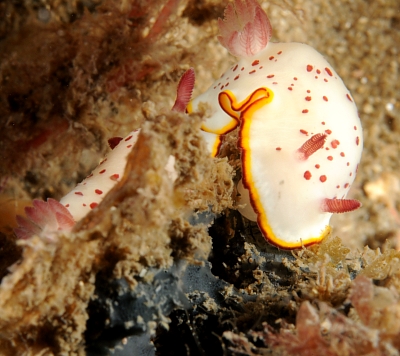
Concerning message #18484:
Hi Bill,
We found these Chromodoris daphne feeding on a black sponge on two recent dives, one at Fly Point and the other at The Pipeline. These dive sites are at opposite ends of Nelson Bay Beach. There is some discussion on where to find these nudibranchs in an earlier message by Dez Paros. We usually find these nudibranchs in less than 12 metres in the zone where there is a mixture of seaweed and sponges.
Locality: The Pipeline, Nelson Bay, Port Stephens and Fly Point, Port Stephens-Great Lakes Marine Park, Port Stephens, 5 metres, New South Wales, Australia, Pacific Ocean, 09 January 2009 & 10 January 2009, Sandy bottom sponges, bryozoans, soft corals, hydroids and ascidians. Length: 30 mm. Photographer: Leanne and David Atkinson.
Regards,
Leanne & David Atkinson
atk@hunterlink.net.au
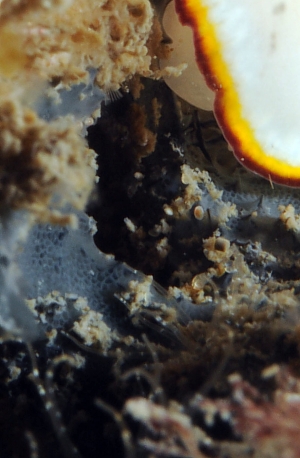
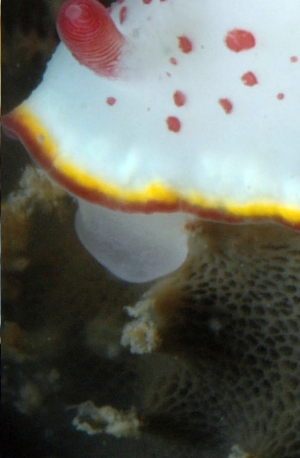
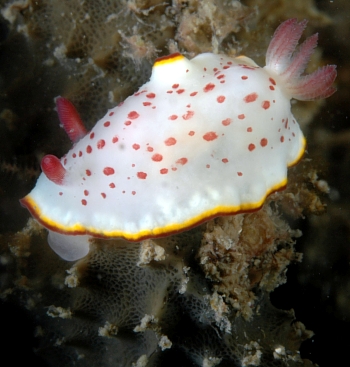
Dear Leanne & David,
Thanks for these records. All things being equal, it is the animal's food which is the most important factor in determining whether a nudibranch will be present at a particular place. My earlier records of this species feeding have always been on the dark purplish darwinellid sponge Chelonaplysilla violacea. Your earlier find on a brownish sponge [message #18549] is interesting - but puzzling, because I haven't been able to identify the sponge past its membership of the Darwinellidae. The sponge in this message is almost certainly Chelonaplysilla violacea, but the bluish regions are puzzling. I wondered if two sponge species were interwoven, but I suspect the bluish regions are paler parts of the Chelonaplysilla - perhaps where the slug has been feeding. I would be interested in your comments. Do you perhaps have a photo showing the join between blue and darker regions more clearly?
Best wishes,
Bill Rudman
Chromodoris daphne feeding observation [2]
November 27, 2006
From: Bill Rudman

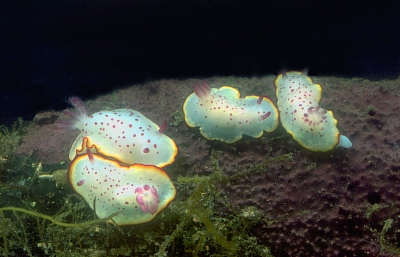
To accompany Leanne & David Atkinson's message [#18549], here is another record of Chromodoris daphne feeding.
Locality: Shiprock, Port Hacking, Sydney, New South Wales, Australia. 7 m. 20 December 1982, many specimens, 20-35 mm long on food sponge. Coll: G. Avern. AM C137068. Photos: Bill Rudman.
Many specimens were found, all on a large empty beer bottle which was completely covered in a colony of the purple darwinellid sponge Chelonaplysilla violacea.
Best wishes
Bill Rudman
Chromodoris daphne feeding
November 27, 2006
From: Leanne & David Atkinson
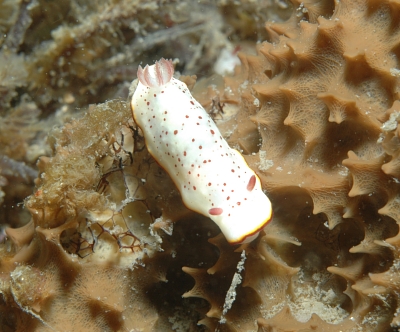
Concerning message #18378:
Hi Bill,
We came across this Chromodoris daphne we think was feeding and thought it might be of interest.
Locality: Little Beach, Fly Point Marine Reserve Port Stephens, 8 metres, NSW Australia, Pacific, 12th November 2006, Sandy bottom scattered sponges, kelp, ascidians soft corals and gorgonias. Length: 40 mm. Photographer: Leanne & David Atkinson.
The upper shot shows the sponge, the damage where feeding has occurred and a mucus trail to the Chromodoris daphne. The lower shot quite clearly shows the mouth everted.Water temperature was 19 degrees celcius.There didn't seem to be any other messages or information about its food on the site.
Regards,
Leanne & David Atkinson
atk@hunterlink.net.au
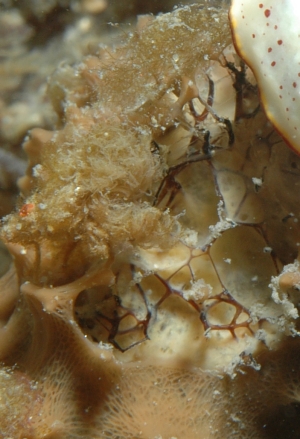
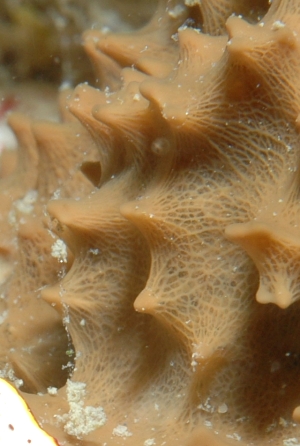
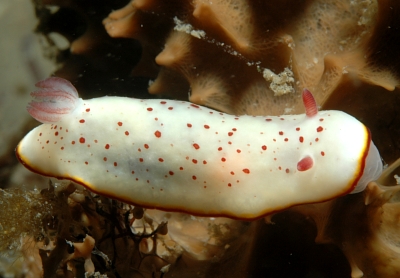
Dear Leanne & David,
This is a very valuable addition to our knowledge. I have added a couple of closeups to show the damage and sponge structure in more detail. The sponge is a darwinellid, and I suspect a species of Chelonaplysilla but will need to check with Prof. Bergquist. Your mention about no feeding information on the site for this species surprised me as I thought I had photos of it on a discarded beer bottle which was covered in the purple sponge Chelonaplysilla violacea. On checking I have only a very cursory reference on the Fact Sheet so I have prepared a fuller message to accompany your record.
It's very good to have some confirmatory observations - and interesting from the sponge point of view as well because we still have a lot to learn about how many species of Chelonaplysilla there are.
Best wishes,
Bill Rudman
Chromodoris daphne laying eggs
March 27, 2006
From: Leanne & David Atkinson
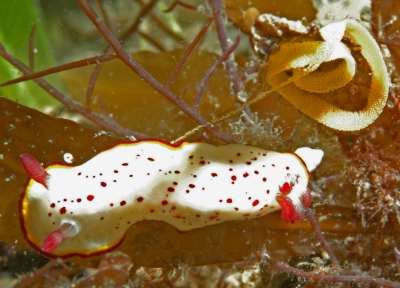
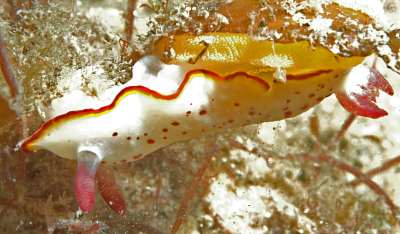
Dear Bill,
We were thrilled to find this Chromodoris daphne laying eggs on our last dive. Sadly we were still learning to use our newly housed digital camera and badly overexposed the shots showing the eggs coming out. It was definitely laying these eggs and not just crawling over them.
Locality: Fly Point Marine Reserve Port Stephens, 5 metres, New South Wales, Australia, Pacific Ocean, 18.03.2006, Sandy bottom seaweed with scattered sponges and kelp. Length: 25 mm. Photographer: Leanne & David Atkinson.
Regards,
Leanne & David Atkinson
atk@hunterlink.net.au
Atkinson, L.& D., 2006 (Mar 27) Chromodoris daphne laying eggs. [Message in] Sea Slug Forum. Australian Museum, Sydney. Available from http://www.seaslugforum.net/find/16171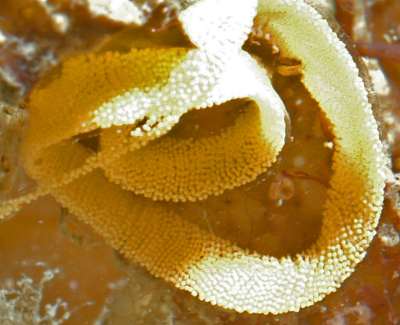
Dear Leanne & David,
I'm thrilled you found this as well! As far as I can recall, we have no information on the egg ribbon and developement of this species up until now. I believe you when you say you saw this animal laying the egg ribbon and anyway I can see a string of eggs leading from the ribbon to the animal suggesting it was disturbed by your interest and stopped laying before it was finshed. The eggs are relatively large so I suspect C. daphne either has lecithotrophic larvae [larvae hatch out as swimming veligers but only stay in the plankton for a short period and don't feed] or has direct development [larvae hatch out of eggs as small crawling slugs]. This is interesting because it fits in with the relatively small geographic range of this species in eastern Australia [southern Queensland and New South Wales].
Best wishes,
Bill Rudman
Octopus & Chromodoris daphne
November 29, 2002
From: Sean P. McMahon
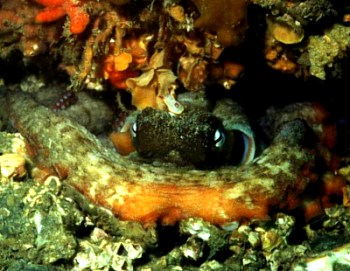
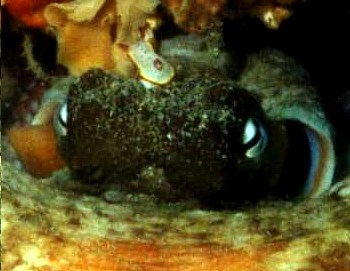
Gudday, I really enjoy this site. I thought I'd send in this picture, its not a great shot but its interesting. The photo of a Chromodoris daphne and an octopus was taken at Shiprock, Port Hacking [Sydney, NSW, Australia] in 14 meters of water (7/11/2002), there are a lot of Chromodoris daphne there at the moment. What happend was the octopus came out of its hole to have a look at me, in doing this it knocked the nudibranch off the sponge above it and it landed on the octopus's head. The nudibranch crawled around on the octopus's head for at least a minute before crawling back onto the spounge above. The octopus ignored the nudibranch the whole time.
Regards,
Sean.
sean.mcmahon1@defence.gov.au
Thanks Sean,
I'm glad you saw how the slug got on the octopus's head - otherwise it would have become another of 'life's little mysteries'
Cheers,
Bill Rudman
Re: Chromodoris daphne
January 18, 2001
From: Wayne Ellis
Hi Bill,
Saw Des Peroz's C. daphne question. This species appears common inside
Mooloolaba Harbour, the estuary of the Mooloolah River [sthn Queensland]. This is an extremely variable environment with a strong tidal flow.
Regards
Wayne
glaskin@ozemail.com.au
Ellis, W., 2001 (Jan 18) Re: Chromodoris daphne. [Message in] Sea Slug Forum. Australian Museum, Sydney. Available from http://www.seaslugforum.net/find/3543Thanks Wayne,
Bill Rudman
Chromodoris daphne - where does it live?
January 5, 2001
From: Des Paroz
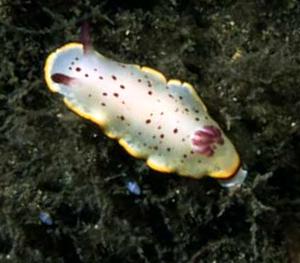
Dear Bill
A Happy New Year to you and all the participants in the Sea Slug Forum. Over the past few weeks I have taken advantage of the tides and general conditions, and have made a few dives at Shiprock [Port Hacking, Sydney, New South Wales].
On the first of these dives I found a species that I have not otherwise seen, which I believe to be Chromodoris daphne. On reviewing your site, I noticed that the only info relating to the species is your original entry with photos taken by you at Shiprock, some years back.
Is this species fond of sites with tidal flows? I noticed on Wayne Ellis' Nelson Bay species list that it is a species also found there. These photos were taken on a 2.0m high tide on Boxing Day, [Dec 26, 2000] and were photographed on a small rocky outcrop at the bottom of the wall in about 14m. Water temp was 24C.
Best regards
Des
des@paroz.com
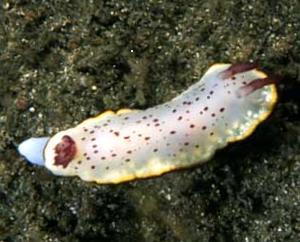
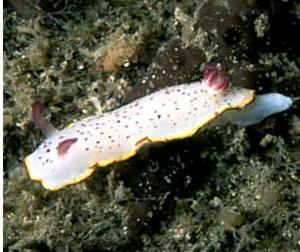
Dear Des,
We haven't got that many records of C. daphne. Around Sydney, Shiprock, Port Hacking has been a place where it has been found, but that may be because it is regularly visited by divers. It has also been recorded at Watson's Bay in Sydney Harbour. Elsewhere in New South Wales it has been found at Fly Point in Port Stephens. There is a lot of tidal movement there but until areas without much tidal flow are investigated we can't say much. On the other hand it has also been found intertidally at Stradbroke Island in Moreton Bay in southern Queensland and on the southernmost reefs of the Great Barrier Reef.
With so little information available it is hard to say anything sensible about why or where you are likely to find a particular species. Where a species actually lives, in a particular geographic area, is the result of a complex of factors, not the least of which is the presence of its food. If its food is not present then larvae will not settle from the plankton, and after they settle, if there is not sufficient food they will die from starvation before they reach maturity. A critical factor then is whether the locality is suitable for the food organism to survive. I have a picture of many small juveniles of the pink Victorian colour form of Noumea haliclona. One time at Mallacoota, on the border between New South Wales and Victoria, in southeastern Australia, I came across a small rocky bay where the intertidal rocks were carpeted in a bright pink sponge which was infested with juvenile Noumea haliclona. This was seemingly an ideal spot for the sponge. There were many millions of animals of Noumea haliclona there. I returned a month later to find a storm had washed away all the sponge and no Noumea could be found. So what seemed a perfect spot for Noumea haliclona was in fact a death trap.
Basically it is difficult to determine where an animal will be found. That's what makes nudibranch fieldwork both exciting, but also very frustrating.
Best wishes,
Bill Rudman.
